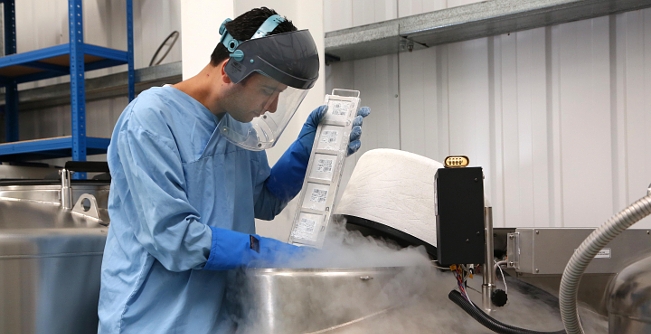With Stem Cell Awareness Day taking place on the 8th October, we decided to find out what these wondrous cells can offer parents.
Nestled in a small industrial estate near Heathrow Airport is where you’ll find the Smart Cells stem cell storage facility and with its nondescript location, you could be forgiven for not giving it a second thought. However, appearances can often be deceiving, as what goes on behind their doors is sensational work in the scientific field.
Founded in 2000 by couple Shamshad and Fehmina Ahmed, Smart Cells are the UK’s oldest private stem cell storage facility and have since stored over 30,000 samples of cord blood and cord tissue from over 70 countries around the world. An impressive feat and the possibilities for this procedure appear to be limitless, with stem cell therapy having already successfully treated conditions such as leukaemia, anaemia and Non-Hodgkin’s lymphoma. With the medical benefits of stem cell therapy continuously evolving, this represents a promising time for the world of medicine.
First things first, what exactly are stem cells?
Essentially, these are cells found in the body that serve as a repair system for other cells and the immune system. They function by transforming into blood, bone, tissue and organ cells when needed to, finding their way to injured cells in the body, effectively replacing them and helping a patient’s recovery.
How do they work?
Smart Cells retrieve their stem cells from umbilical cords. Performed after the birth, this risk-free process is vital, as it will happen only once and the cells can be easily extracted from the cord blood. Umbilical cords contain the greatest concentration of these cells because placental blood is a great source for them. In this instance, they are referred to as ‘unattached cells’ or ‘virgin cells’, meaning they are in their ideal condition.
Once they replace the faulty cells in a body, they become master cells. Whilst they do not always manage to rid the body of a disease, they can help the patient’s condition significantly, even with illnesses such as cerebral palsy, which is incurable. This treatment therefore represents an opportunity for parents to protect their family against serious illness or disease.
Although parents may worry that the extraction could interfere with what is arguably the most magical moment of their lives, after the baby is born, the placenta and umbilical cord are actually taken into a separate room for the phlebotomist (blood collection specialist to you and me!) to extract the cord blood. This means it’s entirely non-invasive for both the mother and newborn baby.
After the phlebotomist extracts the cord sample, the sample will be packed into the Smart Cells kit and once the parents have informed the company, it will be sent to the facility. Once there, it is placed in a sterile and controlled environment, with the processing undertaken by specialist staff. Sterility is of the upmost importance as in case of an accident, such as blood loss, the room cannot be contaminated. The red blood cells and white blood cells are then separated, with the white blood cells and any cells with potential therapeutic value being stored.
How are they stored? A Freezer?
To store the cells, Smart Cells choose to store volume reduced blood instead of whole blood for a number of reasons. Aside from being the industry standard used in the NHS Cord Blood Bank, the Anthony Nolan Trust and other private facilities around the world, there are distinct medical benefits to using this system.
For starters, it’s safer as the freezing process can damage red blood cells, creating debris and free haemoglobin when thawed. This can cause kidney damage, post-transplant complications and blood type incompatibilities.
The reduction method reduces the red blood content, meaning the reactions are minimised and there is no need to wash it after thawing, so less risk of losing important cells. The volume reduction also naturally makes the sample size smaller, which is important because the substance DMSO is used when freezing.
Dimethyl Sulfoxide (DMSO) is an organic compound which penetrates skin and membranes without damaging them and can carry compounds into the biological system. However, it can also cause cardiac problems, breathing issues, serious high/low blood pressure. By making the sample of blood smaller and more concentrated, there’s less DMSO involved so less risk.
Once this is completed, the sample is placed in a ‘Pall Bag’ (a sample bag split in a 80/20 ratio) to be frozen in a controlled-rate freezer where it will slowly freeze for an hour until it reaches -196˚ C. The moment it reaches this temperature, it is finally placed in a long-term storage tank and can remain there for up to 25 years or until it is needed for a transplant.
Public and Private
It’s vital that parents know the difference between what is being offered by public facilities such as the NHS cord blood bank and private facilities like Smart Cells. As with any new subject, it’s better to be well-informed before making any decisions – particularly when they are vastly different options.
Donating cord blood to publicly or government-funded facilities is free of charge to the donor, but is an entirely altruistic act. These banks are set-up for generous individuals to provide cord blood, which will then be stored indefinitely for possible transplant. Bottom line, the product will not be stored specifically for you or your family, but for any patient that may need that special tissue type.
Private facilities instead provide the opportunity for donors to store cord blood for their own use. This means you can store the product for potential use by a member of your family in the future, who will have a matchable unit ready if they ever become sick with a disease that can be treated with stem cells. Essentially, a company like Smart Cells offer parents the chance to safe-guard their family against these specific diseases, and considering we spend most our waking moments wanting to protect our kids, this definitely warrants thinking about.
Weighing the potential
Smart Cells are honest in admitting their service isn’t cheap, with costs for the procedures ranging from £1995 for cord blood storage to £2545 for cord blood & cord tissue storage. However, if more people invested, the cost would naturally reduce and the company do offer numerous payment plans for couples wishing to have this done. It’s best for parents to envision this as a form of investment, similar to health insurance.
One irrefutable factor is that the benefits of the process are almost limitless, with the cells being stored for 25 years and the option to renew or end the deal 6 months before its completion. We can’t predict the medical landscape in 5 or 10 years time, but with the continued studies into how stem cells work, it seems a safe bet that they will inevitably be able to cure a broader spectrum of conditions and diseases – there are already a few trial treatments for MS, strokes, Diabetes and Parkinson’s.
Private companies are usually synonymous with profit-making, but this could not be further from the truth with Smart Cells. Shamshad and Fehmina’s primary goal is to help out as many lives as possible and the money involved should be perceived as more of an investment in your children’s future than anything else.
Just before we left, Smart Cells were preparing to release their tenth sample for use in a transplant. Asking whether or not they had seen this as a symbolic figure, their answer was incredibly humble. Whilst this moment had some added importance for the history of the company, their overriding concern for their customers was clear for all to see, for them, it seems each transplant is just as important as the last.








